MayMaan delivers clean combustion solution
03 July 2023
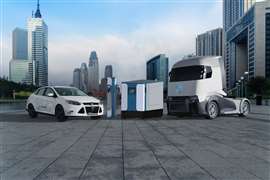 While the company is initially focusing on power generation, it said the AquaStroke system’s scalability means it can be used wherever an ICE is currently used. (Photo: MayMaan Research)
While the company is initially focusing on power generation, it said the AquaStroke system’s scalability means it can be used wherever an ICE is currently used. (Photo: MayMaan Research)
Internal combustion engines (ICEs) have seen dramatic improvements in efficiency, yet there has been a longstanding issue of energy loss from the fuel being burned. Some estimates put it at anywhere from 45% to 65% of fuel energy lost in the form of heat, much of it eventually dispelled out the exhaust pipe.
“In the process of the engine making heat, it is also making other undesirable products,” noted Eitan Schmueli, president of MayMaan Research. “When a combustion temperature goes above 1,200 degrees C, it creates NOx.”
MayMaan, a cleantech company based in Florida, developed a solution that it said puts wasted energy to use, while utilizing a clean, renewable fuel source. According to the company, its AquaStroke technology takes advantage of pressure generated by steam that is created by burning a 70% water/30% ethanol or methanol fuel mix.
 Eitan Shmueli, president, MayMaan Research
Eitan Shmueli, president, MayMaan Research
“The potential benefits,” Eitan said, “include no NOx, cool combustion and the use of renewable sources that do not produce any diesel particles. And if you’re using bioethanol or bio-methanol, they are both considered a carbon-neutral fuel.”
Other benefits include the ability to utilize the proven combustion engine design as well as a liquid fuel. The water/ethanol fuel mix can be stored and delivered in the same fashion as diesel and gasoline and without the need for major changes to the existing fueling infrastructure, Eitan pointed out.
Ethanol and methanol are also more cost-effective to produce than gaseous fuels like hydrogen and do not require delivery under high pressure, he continued. “And most important, it performs. The end user will not feel the difference when using one versus the other. You don’t need to have a learning curve or try to convince everybody that this is better and cleaner.”
Steam-generated torque
Within the AquaStroke combustion process, fuel is pumped at a very high pressure and injected directly into a modified combustion chamber of a conventional piston engine. Ignited by a spark, the Aquastroke cycle is created by using the thermal and pressure properties of the combustion chamber and fuel.
“The heat that usually is lost in an internal combustion engine is turning into steam inside the combustion chamber. Instead of wasting the heat, we’re using the heat. We’re using some of that energy,” Eitan said. “And because we are using some of that energy, the combustion temperature does not go above 900 degrees C, so essentially, we do not create any NOx.
“But we’re doing something more than that. We’re increasing the efficiency and creating a high torque because of the steam, which is produced at an ideal position between the crank and the rod angle, where you have more ‘push’ in the engine.”
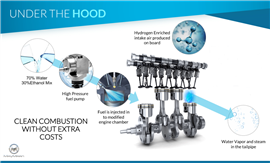 Within the AquaStroke combustion process, fuel is pumped at a very high pressure and injected directly into a modified combustion chamber of a conventional piston engine. (Photo: MayMaan Research)
Within the AquaStroke combustion process, fuel is pumped at a very high pressure and injected directly into a modified combustion chamber of a conventional piston engine. (Photo: MayMaan Research)
According to MayMaan, the piston is pushed down the entire power stroke, resulting in a very high torque in a wide range of the engine’s rpm. Eitan compares it to the force applied when pedaling a bicycle. “It’s like if you were riding a bicycle and push the pedal when it’s all the way up or when it’s at an angle. When it’s at an angle, you have more leverage to push it,” he explained.
The result is “diesel-like torque” or even higher in some cases, he said, all with minimal changes to an existing engine. “We’re changing pressures, timings and conditions for this whole thing to work within the engine,” Eitan said. “But the principle of the engine is still there. It was just changing the stroke itself.” Specialized coatings and lubricants are also used to minimize corrosion risk.
“This leads to an engine that surpasses diesel in torque and power output per displacement,” Eitan stated, “but without all the negative impact on the environment.”
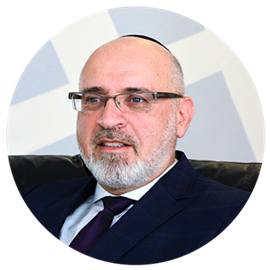 Doron Shmueli, CEO, MayMaan Research
Doron Shmueli, CEO, MayMaan Research
Scalable solution
“The AquaStroke technology has been successfully tested in engines from 400 to 6,200 cc. We have single piston engines, four piston engines and eight piston engines running. The same method can be used to run a cargo ship but with a much larger engine,” said Doron Shmueli, CEO of MayMaan. “We’re also not limited to certain industrial sectors.”
“The system’s scalability means it can be used wherever an ICE is currently used,” Eitan said. “You can replace the diesel in generators, pumps, air compressors, trucks, locomotives – in everything where there is a diesel engine. Every size engine that we develop can apply to different industries.”
For example, take a two-liter engine that the company is currently using for power generation. “The same engine can be used for pumps, compressors or generators. It can also be a small range extender for a box truck or for a small commuter boat,” said Doron. “As we produce different sizes of engines, they can be used for different applications.
“Technologically, we can convert any internal combustion engine to an AquaStroke engine, generally speaking.”
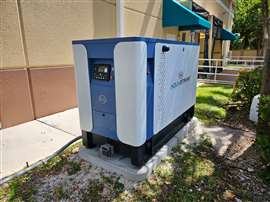 Generator sets utilizing Aquastroke-equipped engines are currently available rated 20, 35 and 120 kW single- or three-phase power. (Photo: MayMaan Research)
Generator sets utilizing Aquastroke-equipped engines are currently available rated 20, 35 and 120 kW single- or three-phase power. (Photo: MayMaan Research)
However, Eitan noted economies of scale come into play. “Commercially, there is a point where if you go above a certain size engine, it makes sense economically to retrofit it, but when it’s less than that size or the cost is lower, it makes sense to replace it. For example, engines above roughly 270 hp (200 kW) would be more practical candidates for a retrofit.”
Power generation
While it sees broad application potential, MayMaan is initially focusing on power generation, including the development of its own line of generator sets utilizing Aquastroke-equipped engines.
Three models are currently available rated 20-, 35- and 120-kW single- or three-phase power and equipped with retrofitted 1.5 L, 2.0 L and 6.6 L engines, as well as components from established suppliers, including DeepSea or Datakom controllers. The models are being offered for pre-order, with anticipated delivery in late 2023/early 2024.
The gen-sets are suited for residential and commercial backup power, and peak shaving, and can also provide Level 2 off-grid charging of electric vehicles.
“We all know the biggest problem for battery technology is there’s not enough electricity to charge the electric cars,” Doron said. “We can help by providing carbon neutral power to charging stations.”
MayMaan recently announced a collaboration with Swedish energy giant Vattenfall to further the development of fossil-free energy generation. This involves improving the charging infrastructure needed to enable the broader adoption of EVs.
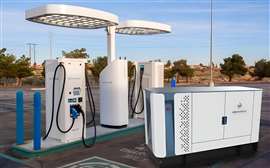 The gen-sets are suited for residential and commercial backup power, and peak shaving, plus can provide Level 2 off-grid charging of electric vehicles. (Photo: MayMaan Research)
The gen-sets are suited for residential and commercial backup power, and peak shaving, plus can provide Level 2 off-grid charging of electric vehicles. (Photo: MayMaan Research)
Cell towers are also a primary target for the company. “Every cell tower needs a generator, and usually they’re small generators, 20 to 35 kW,” said Doron. “We have major cell tower companies engaging with us regarding replacing their diesel generators with a cleaner alternative.”
Business strategy
In early May, MayMaan announced a commitment by WAVE Equity Partners LLC, for a $30 million Series A Preferred investment to help accelerate AquaStroke’s development and deployment. This was a welcome boost for the company, which had already started small series production of AquaStroke-equipped generators for strategic customers and field testing.
Yet, MayMaan’s business model is not to become an engine manufacturer. Rather, it is to form strategic partnerships with established global suppliers who can help take the company’s technology mainstream.
“Our business model is contract manufacturing and licensing. We’re not planning to be a manufacturing facility,” Doron said. “Basically, we are a technology and R&D company. We are going to work with engine manufacturers and generator packagers. They are the ones that will license, manufacture and warranty our technology and products to the end user.
“It’s just going to be spec changes for the engine manufacturer, and for them to take it to a point of mass production will be very easy for them. The objective is to provide companies with a faster, easier means to lower their products’ carbon footprint and thus reduce regulatory pressures.”
Under this model, MayMaan provides the technology and the R&D to enable companies to adapt AquaStroke to their applications. Initially, this will be in the form of retrofitting existing products.
“But this is only the first stage when we enter the market. After that, the engine manufacturers are going to build the block and the whole engine with our technology. It is not going to be a retrofit anymore,” Doron stated. “Right now, we’re talking about retrofitting existing engines to enter the market. Later, the engines will be manufactured completely as a MayMaan engine.
“They will sell it and we will sell it, but the most important thing is that they will be doing the manufacturing. This is why we feel we can take market share very fast.”
STAY CONNECTED




Receive the information you need when you need it through our world-leading magazines, newsletters and daily briefings.
POWER SOURCING GUIDE
The trusted reference and buyer’s guide for 83 years
The original “desktop search engine,” guiding nearly 10,000 users in more than 90 countries it is the primary reference for specifications and details on all the components that go into engine systems.
Visit Now
CONNECT WITH THE TEAM










